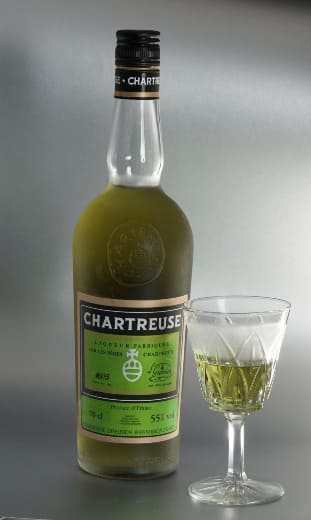



Chartreuse is a shade where green vivaciously nuzzles with yellow to create a mania in the art, fashion and toy industries.
But by the late 1700s, the dye was suddenly recalled from the public sphere as many succumbed to poisoning due to the arsenic contained in it. But the swift end to the trend was not final. Chartreuse made a comeback later, when harmless methods to recreate the sensation were discovered. Stop! Tell me, from where did the colour get its curious name - 'Chartreuse'?
 Cut to the 11th century.
Cut to the 11th century.
A group of seven Carthusian monks settled in the desert area of Chartreuse, France, in the western French Alps where they painfully built the Grand Chartreuse monastery. Pious, abstemious, spartan, the monks would now lead their quiet time in prayer and contemplation, sustaining themselves by doing odd jobs like fish farming, forestry and livestock breeding.
In the 17th century, the monks received an emissary from King Henry IV named François-Annibal d’Estrées. The army officer who came to the monastery gifted the pious monks an ancient manuscript sourced from an alchemist he had met. It was a recipe that promised to create the 'Elixir of Long Life.' This was the catch: it demanded 130 different herbs for the making of the liqueur!
The manuscript they got was so complex that the puzzled monks sent it to the monastery La Grande Chartreuse situated in the mountains of France for unlocking its secrets.
It was in 1737 that Frere Jerome Maubec, an apothecary working in the monastery, got a grip on the text, deciphered it and wrote out a final recipe for the elixir. Élixir Végétal de la Grande Chartreuse came into existence. Look at its colour! With that peculiar green shade, the liqueur had a charisma that could send ripple waves in the art and fashion industry.
A new colour - Chartreuse - was added to the palette (perhaps no other colour is born out of a drink, note it)!
The green hue of the French liqueur comes straight from chlorophyll contained in the botanical ingredients included in the recipe. If you are not comfortable with the colour green, Chartreuse also comes in yellow which has a lower quantity of alcohol.
In the initial days, the distribution of the new herbal tonic (liqueur) fell on the shoulders a monk, Frère Charles who went around in his moly delivering the small bottles in little villages in the neighbourhood. Demand steadily increased until tragedy struck in the form of the French revolution. As it started, all religious orders were asked to wind up their operations, hand them over to the new regime and leave the country for good. The Carthusian monks made sure to smuggle out the secret recipe as they left the country in order to start afresh in Spain.
 Élixir Végétal de la Grande Chartreuse. (Image: Chriusha/Хрюша. via Wikimedia Commons 3.0)
Élixir Végétal de la Grande Chartreuse. (Image: Chriusha/Хрюша. via Wikimedia Commons 3.0)In 1816, when things calmed down, the Carthusians returned to their old monastery to resume operations, now creating the milder form of Chartreuse, the yellow one.
The second setback came when the French government nationalized the Chartreuse distillery in 1903, expelling the monks once again. In Tarragona, Spain, the Carthusians built their new distilleries, resuming production while the French authorities sold the Chartreuse trademark to a group that set up the Compagnie Fermière de la Grande Chartreuse. But the government-sponsored company was a grand failure. As it went bankrupt after a few years, the monks were quick to buy up all the shares, paving the way for their return.
130 ingredients! Do they always get it right to make the taste consistent? What is the secret behind the mix?
Over centuries avid fans have been racking their brains to tease apart what hit them on their taste buds. 'Intensely floral', 'very sweet', 'herbacious'... Beyond such abstractions that hardly defined the liqueur, the monks have been successful in maintaining the enigma that shrouds Chartreuse liqueur over centuries.
Do you know? Among the hundreds of monks and nuns living in the charter houses, only two of them know the full recipe of Chartreuse. The vow of silence they have taken makes the secret impervious for us to take a peek into.
When a filmmaker approached the monastery sometime back for a documentary, he didn't know he would have to negotiate for 16 years to reach an agreement. The monks keep it that close to their heart.
The mystique of Chartreuse has caught the attention of high and low cultures in the 20th century.
 (Image: Ralf Roletschek/GNU Free Documentation License 1.2)
(Image: Ralf Roletschek/GNU Free Documentation License 1.2)Sir Henry Morton, journalist and explorer could set out in search of the legendary explorer Dr David Livingstone only with a bottle of Chartreuse. Elsewhere Charles de Gaulle, French statesman was enjoying his Chartreuse-spiked hot chocolate at his evening parties. Come to the movies. You hear the green name pop up in the movies of Alfred Hitchcock and Quentin Tarantino. In The Great Gatsby, you will catch Jay and Nick talk over glasses filled with the liqueur.
So what does Chartreuse taste like?
Slightly sweet. With a surge of herbals finetuning your tastebuds from the background. Can't blame you if you could picked up notes of honey, saffron, lime, and anise spice.
The liqueur can be enjoyed in many ways. Sip it solo, or with ice. It is one of the favourite ingredients in cocktails too.
Discover the latest Business News, Sensex, and Nifty updates. Obtain Personal Finance insights, tax queries, and expert opinions on Moneycontrol or download the Moneycontrol App to stay updated!
Find the best of Al News in one place, specially curated for you every weekend.
Stay on top of the latest tech trends and biggest startup news.